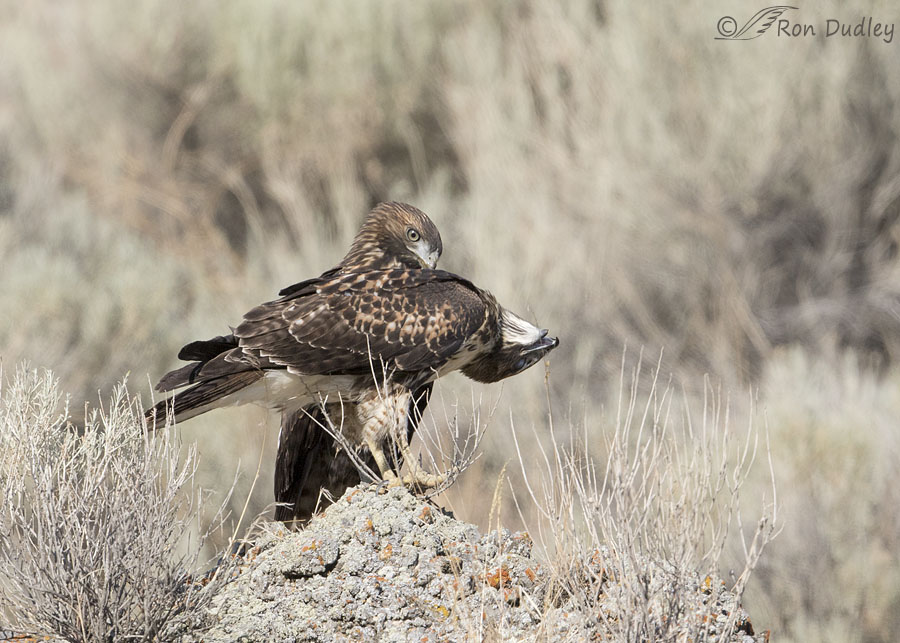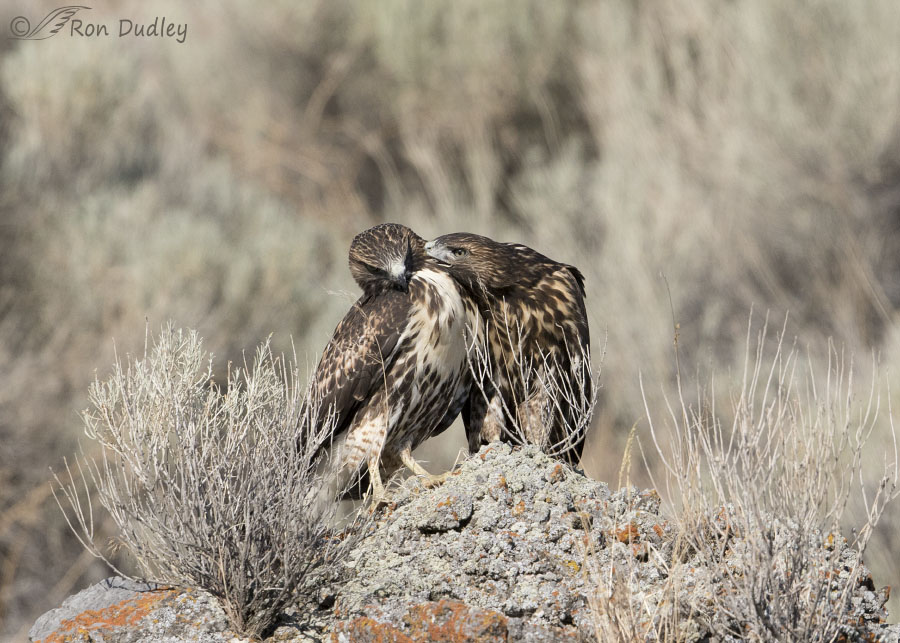And one of them was really getting into it.

1/2500, f/7.1, ISO 640, Canon 7D Mark II, Canon EF 500mm f/4L IS II USM, not baited, set up or called in
A year ago this month I spent some time with recently fledged Red-tailed Hawk siblings as they were learning how to survive (and apparently how to enjoy life) out of the nest.
The bird in the back was really working over its sibling’s plumage with its bill and the recipient of all the attention certainly seemed to be enjoying it, so much so that “he” rolled his head over upside down, closed his nictitating membranes, opened his bill and even raised one foot as if in ecstasy. It reminded me of the reaction I used to get from one of my dogs (Jake, a Springer Spaniel with acres of lips) when I would scratch his neck as he laid upside down next to me on the sofa.
Technically I believe this behavior is called “social grooming” but it looked like old-fashioned nuzzling and cuddling to me.
And it sure was fun to watch.
Ron
Addendum – an afterthought, really:
Since the photo above doesn’t really show one bird’s bill buried in the plumage of the other (it might be interpreted that the rear bird is only watching its sibling acting goofy and has nothing to do with causing the silliness) I decided to include another photo, taken a few seconds before this one, that I posted last year.

In it we actually see the “nuzzling and cuddling” I referred to above that partially precipitated the reaction of the second bird in the previous photo.
And by the way, when I first noticed the contrasting coloration of these two youngsters I had to wonder if the one on the right eventually became a rufous morph just like its mother (a spectacular-looking bird I’ve posted here often). I have no idea how their genetics works for that trait, nor do I fully understand all the changes that occur in this species from juvenile to adult plumage, but based on color it seems (potentially) logical to me.
Ok, I’m finally gonna quit now. Really…


Love these birds….beautiful pictures too, my friend!
Tim
Beautiful photos. Love seeing raptors being affectionate!
Although the experts will tell you that redtails are solitary hunters, they’re far more social than people know. We know that through watching the Cornell redtails over time. No, they’re not social like Harris’ hawks, but they aren’t as solitary as many people will tell you, either. Then, there’s also the issue of kids just being kids.
Love it!
Good.
Nuzzling and cuddling works for me. As does the ‘I took the blame for that thing you did, so you have to give me a neck rub…’
Definitely a delightful moment to start the day when I finally got the PC up and running.
Thanks, EC. I have a little PC challenge in front of me this afternoon too. Not looking forward to it.
What a revelation. I had no idea that hawks exhibited this behavior. Hawk affection seems almost an oxymoron. One wonders if mating adults do this, too.
Lyle, I’ve never seen mating hawks do anything similar and I’ve photographed them mating multiple times.
A red-head…just like her mother. 😀 And that first image made me laugh out loud. Thanks for the morning joy, professor.
You’re very welcome, Arwen. I always enjoy making you laugh.
Interesting series Ron. Always nice to see raptor juveniles having fun enjoying each others company and exhibiting affection toward each other considering how self centered and often cruel their in the nest behavior can be. On a couple occasions over the past few years here we have had one of the eagle chicks push their sibling out of the nest. Of course unless it is captured on a nest cam we have no way of knowing whether it was accidental or deliberate. Excellent photos. Thanks for posting.
Thank you, Everett. Yes, at this stage at least I think they were enjoying each other’s company.
AWWWWW! 🙂 So cute! Too bad it was “one way”. Vertigo pretty good by last evening – overnight and this morning not so much……. 🙁 Their 5 day thing may be more accurate than I hoped…… 🙁
Five days of vertigo – I can’t even imagine how miserable. Best of luck, Judy!
Really?! VBG!! I understand fully – feel the same way when my head or back or both are rubbed, massaged, etc!!
Hey, were all animals, gotta be some similarities!
Love the post!
Ha, you’ve put an image in my head of you getting “the treatment”, Dick. Do you drool during the process like Jake used to? 🙂
Delightful! I love knowing how your ongoing close attention provides you with such heartwarming views of companionship between these young siblings…
Alison, paying close attention pays off when you’re as interested in behaviors as I am. But I’m the first to admit that my high quality super-telephoto lens makes it easier for me to do than it would be for others who don’t have that advantage.
Priceless. Typical sibling behavior would be that they would loook blissful while the “giver” of such bliss is sayinng, ” You have to do my chores for a week, now.” Thanks for sharing.
Thanks, Suzanne. What you describe may be typical behavior for siblings but in this case the bird receiving all the attention wandered off the rock and left its generous sibling behind without reciprocating or showing the least bit of appreciation.